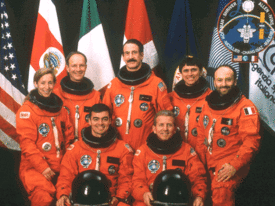STS-46
|
|
| Mission Insignia | |
|---|---|

| |
| Mission Statistics | |
| Mission: | STS-46 |
| Shuttle: | Atlantis |
| Launch Pad: | 39-A |
| Launch: | July 31, 1992, 9:56:48 a.m. EDT. |
| Landing: | August 8, 1992, 9:11:50 a.m. EDT, Runway 33, Kennedy Space Center. |
| Duration: | 7 days, 23 hours, 15 minutes, 3 seconds. |
| Orbit Altitude: | 230 nautical miles (426 km) |
| Orbit Inclination: | 28.45 degrees |
| Distance Traveled: | 3,321,007 miles (5,344,643 km) |
| Crew photo | |

| |
STS-46 was a NASA space shuttle mission launched in 1992.
| Contents |
Crew
- Loren J. Shriver (3), Commander
- Andrew M. Allen (1), Pilot
- Jeffrey A. Hoffman (3), Mission Specialist 1
- Franklin R. Chang-Diaz (3), Mission Specialist 2
- Claude Nicollier (1), Mission Specialist 3 - ESA Switzerland
- Marsha S. Ivins (2), Mission Specialist 4
- Franco Malerba (1), Payload Specialist 1 - ESA Italy
Mission Parameters
- Mass:
- Orbiter landing with payload: 94,676 kg
- Payload: 12,164 kg
- Perigee: 425 km
- Apogee: 437 km
- Inclination: 28.5°
- Period: 93.2 min
Mission Highlights
Mission's primary objectives were the deployment of ESA's European Retrievable Carrier (EURECA) and the joint NASA/Italian Space Agency Tethered Satellite System (TSS). EURECA was deployed a day later than scheduled because of a problem with its data handling system. Seven and a half hours after deployment, the spacecraft's thrusters were fired to boost EURECA to its planned operating altitude of around 31O miles. However, thruster firing was cut to six minutes from 24 minutes because of unexpected attitude data from the spacecraft. The problem was resolved and EURECA was successfully boosted to its operational orbit on the mission's sixth day. TSS deployment also was delayed one day because of the problems with EURECA. During deployement, the satellite reached a maximum distance of only 86O feet from the orbiter instead of the planned 12.5 miles because of a jammed tether line. After numerous attempts over several days to free the tether, TSS operations were curtailed and the satellite was stowed for return to Earth. Seconday payloads included: Evaluation of Oxygen Integration with Materials/Thermal Management Processes (EOIM-III/TEMP 2A), Consortium for Materials Development in Space Complex Autonomous Payload (CONCAP II and CONCAP III), IMAX Cargo Bay Camera (ICBC), Limited Duration Space Environment Candidate Materials Exposure (LDCE), Air Force Maui Optical Site (AMOS), Pituitary Growth Hormone Cell Function (PHCF), and Ultraviolet Plume Instrument (UVPI). Mission extended extra day to complete scientific objectives.
Related articles
- Space science
- Space shuttle
- List of space shuttle missions
- List of human spaceflights chronologically
External links
- NASA mission summary (http://science.ksc.nasa.gov/shuttle/missions/sts-46/mission-sts-46.html)
| Previous Mission: STS-50 |
Space Shuttle program | Next Mission: STS-47 |
